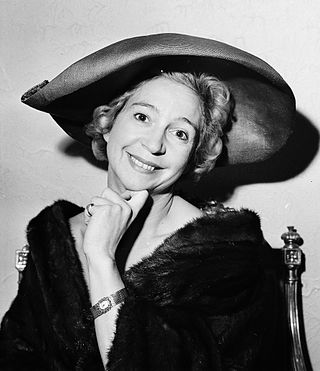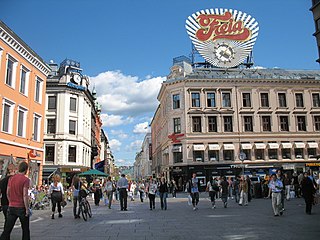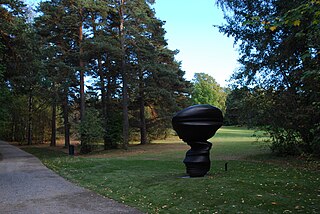
Ekeberg is a neighborhood in the city of Oslo, Norway. The Norway Cup soccer tournament takes place at Ekebergsletta every summer. "Sletta" means "the plain". The painting "The Scream" by Edvard Munch is painted from Utsikten, a part of Ekeberg.

Oslo Cathedral — formerly Our Savior's Church — is the main church for the Church of Norway Diocese of Oslo, as well as the parish church for downtown Oslo. The present building dates from 1694–1697.

Christian Krohg was a Norwegian naturalist painter, illustrator, author and journalist. Krohg was inspired by the realism art movement and often chose motifs from everyday life. He was the director and served as the first professor at the Norwegian Academy of Arts from 1909 to 1925.

Oslo City Hall is a municipal building in Oslo, the capital of Norway. It houses the city council, the city's administration and various other municipal organisations. The building as it stands today was constructed between 1931 and 1950, with an interruption during the Second World War. It was designed by architects Arnstein Arneberg and Magnus Poulsson. The building is located in the city center, in the northern part of the Pipervika neighbourhood, and it faces Oslofjord.

Eva Wenche Steenfeldt Stang, better known as Wenche Foss, was a leading Norwegian actress of stage, screen and television.

Karl Johans gate is the main street of the city of Oslo, Norway. The street was named in honor of King Charles III John, who was also King of Sweden as Charles XIV John.

Jens Thiis was a Norwegian art historian, conservator and a prominent museum director. He was conservator at the Nordenfjeld Industrial Arts Museum in Trondheim beginning in 1895 and director of the National Gallery in Oslo from 1908 to 1941.

Per Pavels Aabel was a Norwegian actor, artist, dancer, choreographer and instructor.

Peer Gynt Sculpture Park is a sculpture park located in Oslo, Norway. The sculpture park was created in honour of the Norwegian writer, Henrik Ibsen as a monumental presentation of one of his plays Peer Gynt, act by act.

Grand Hotel is a hotel in Oslo, Norway. The hotel is best known as the annual venue of the winner of the Nobel Peace Prize.

Vika is a neighborhood in the Oslo city center in Norway. It is located between the Royal Palace, Oslo, Oslofjord, Aker Brygge, Pipervika, Slottsparken, Oslo City Hall, Oslo Concert Hall and borders on the north with Karl Johans gate, the main street of the city of Oslo which hosts Norwegian Parliament Building as well as known for being the hub to major Scandinavian brands, bars and hotels including Grand Hotel, the annual venue of the winner of Nobel Peace Prize and various state dignitaries.

Per Ung was a Norwegian sculptor and graphic artist.

Hjalmar Eilif Emanuel Peterssen was a Norwegian painter. He is most commonly associated with his landscapes and portraits.

Eidsvolls plass is a square and park in Oslo, Norway, located west of the Parliament of Norway Building, south of Karl Johans gate and east of Studenterlunden and the National Theatre. It has been referred to as "the National Mall of Norway".

The Storting building is the seat of the Storting, the parliament of Norway. The building is located at 22 Karl Johans gate in central Oslo, Norway. It was taken into use on 5 March 1866 and was designed by the Swedish architect Emil Victor Langlet.

Egertorget is a pedestrian mall located at the intersection of Karl Johans gate and Øvre Slottsgate in Oslo, Norway.

The Faculty of Law of the University of Oslo is Norway's oldest law faculty, established in 1811 as one of the four original faculties of The Royal Frederick University. Alongside the law faculties in Copenhagen, Lund and Uppsala, it is one of Scandinavia's leading institutions of legal education and research. The faculty is the highest-ranked institution of legal education in Norway and is responsible for the professional law degree, one of the most competitive programmes at any Norwegian university. Those admitted to the law programme at the University of Oslo tend to have an average high school grade that is higher than the highest grade, and are usually the best in their class at high school level.
Marie Karsten was a Norwegian Interior designer. She specialized in furniture and textile design.

Maja Melandsø, born Marie Sofie Melandsø, was a Norwegian architect and painter. She was a pioneer in several areas: she was one of the first women architects to complete their studies at the Norwegian Institute of Technology when she graduated in 1931, she is considered the person to introduce functionalist architecture in Trondheim, and she was one of the first Norwegian female architects with her own practice. Melandsø was involved both in residential construction as well as cultural heritage management. As an architect, she had an extensive output, but apart from the fact that as a newly qualified architect she attracted attention with her funkis-bygg in Trondheim, the buildings she designed were rarely mentioned in architectural literature.
I have designed houses, not buildings. Houses to work in, houses to live in, according to ability. Whether health centers, manor houses, schools, business premises, or houses to live in, they were built on the principle that one square meter too much is as bad as one square meter too little. The houses were big on the inside and small on the outside. I have never recognized the concept of "facade"; all three dimensions are equally important.




















